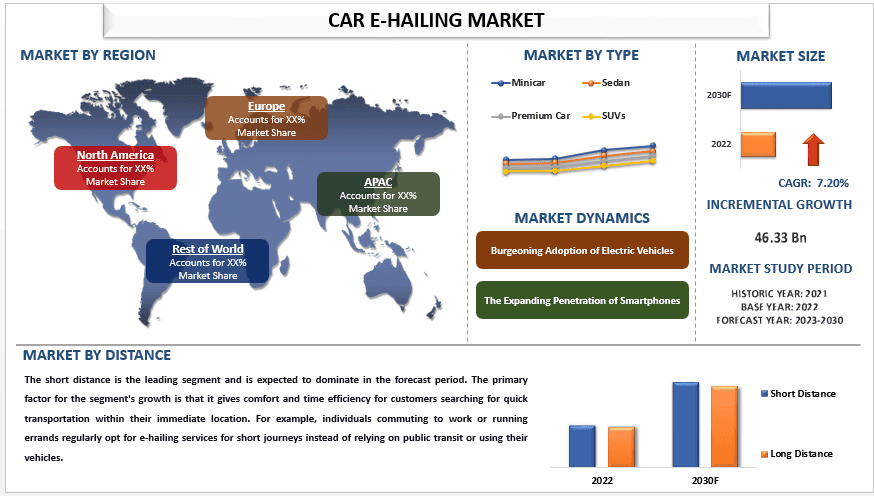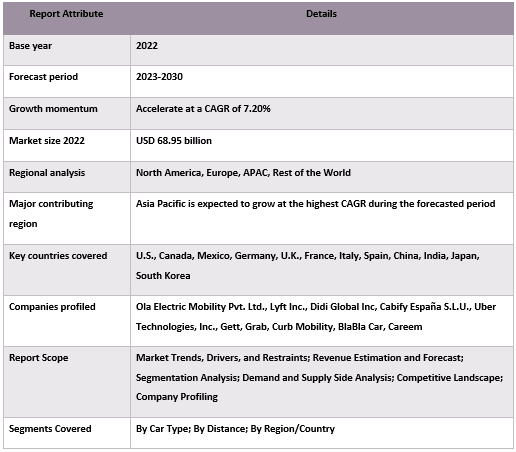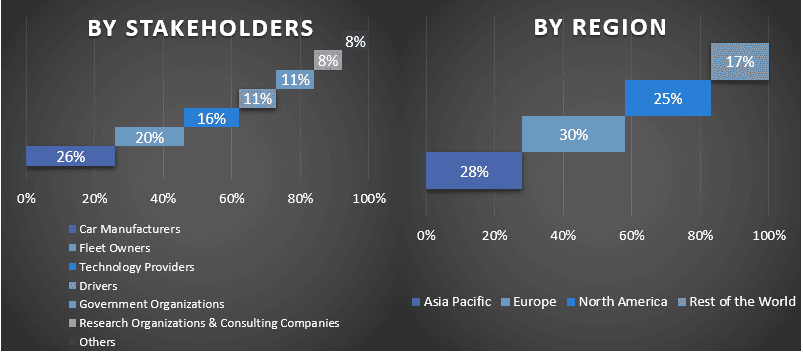カーEヘイリング市場:現状分析と予測(2023年~2030年)
車種(軽自動車、セダン、高級車、SUV); 距離(短距離、長距離); 地域/国 の重視

カーEヘイリング市場は2022年に689億5000万米ドルと評価され、2023年から2030年にかけて7.20%のCAGRで成長すると予想されています。 スマートフォンの価格が手頃になり、より多くの人々が利用できるようになったことで、より多くの人々がEヘイリングアプリに簡単にアクセスできるようになりました。これらのアプリは、シームレスな予約と料金プロセス、リアルタイムの追跡、ユーザーフレンドリーなインターフェースを提供し、カーEヘイリングサービスの全体的な利便性と信頼性を高めます。さらに、スマートフォンはGPSナビゲーションなどの高度な機能を提供し、ドライバーが効率的に乗客をピックアップおよびドロップオフできるようにし、顧客満足度の向上につながります。さらに、スマートフォンの広範な使用により、カーEヘイリング企業は情報を収集し、パーソナライズされたサービスを提供し、全体的なユーザーエクスペリエンスを向上させることができます。モバイルアプリを使用すると、ユーザーは簡単に乗車を予約したり、ドライバーを追跡したり、キャッシュレス決済を行うことができます。スマートフォンの普及が世界的に拡大し続けるにつれて、Eヘイリングサービスの市場も拡大しています。たとえば、SellCellが発表したレポートによると、2022年には、2009年に販売されたスマートフォンの総数は1億7238万台で、2021年には15億1030万台に達し、2027年には16億7610万台に達すると予想されています。したがって、スマートフォンの需要の増加は、今後のカーEヘイリング市場の需要を促進します。
市場で事業を展開している主要企業には、Ola Electric Mobility Pvt. Ltd.、Lyft Inc.、Didi Global Inc、Cabify España S.L.U.、Uber Technologies, Inc.、Gett、Grab、Curb Mobility、BlaBla Car、Careemなどがあります。これらの企業は、ハイテクで革新的な製品/テクノロジーを顧客に提供するために、いくつかのM&Aとパートナーシップを行ってきました。
レポートで提示された洞察
「車種別では、2022年にマイクロセグメントが市場を支配した」
車種に基づいて、市場はマイクロカー、セダン、プレミアムカー、SUVに分類されます。マイクロカーセグメントは2022年に市場を支配しており、予測期間中も同じ傾向を示すと予想されます。マイクロカーは、駐車スペースが限られた混雑した都市部での移動に適しています。コンパクトなサイズにより、操作性と駐車が容易になり、簡単なピックアップとドロップオフが不可欠な人口密集地域での短距離移動に最適です。マイクロカーのサイズが小さいため、車両Eヘイリングサービスプロバイダーは、特定のフリートサイズ内でより多くの車両を運用できるため、販売の可能性が高まります。さらに、マイクロカーの購入と維持に必要な初期投資が少ないため、新規参入者がEヘイリングサービスを確立しやすくなり、その優位性に貢献する可能性があります。
「距離別では、短距離セグメントが現在2022年の市場をリードしている」
距離に基づいて、市場は短距離と長距離に分割されます。短距離は現在、主要なセグメントであり、予測期間中にセグメントを支配すると予想されます。このセグメントの成長の主な要因は、近隣地域内での迅速な輸送を探している顧客に快適さと時間効率を提供することです。たとえば、通勤や用事を済ませる人は、公共交通機関に頼ったり、自家用車を使用したりする代わりに、短距離のEヘイリングサービスを定期的に選択します。さらに、Eヘイリングサービスは、短距離のタクシーサービスの費用対効果の高い代替手段を提供します。ユーザーは、乗車全体に対する定額料金とは対照的に、移動した距離だけを購入することで、お金を節約できます。さらに、Eヘイリングプラットフォームは、高度なアルゴリズムとAIテクノロジーを活用して、短距離のサービスを最適化しています。彼らは、迅速な応答時間、効率的な方向計画、および近隣の乗客とドライバーのスムーズなマッチングを保証します。これにより、Eヘイリングサービスは短距離移動に非常に効率的になり、この市場セグメントでの優位性に貢献しています。
「アジア太平洋地域は2022年のカーEヘイリング市場で最も高いCAGRを促進する」
アジア太平洋地域は、電気自動車の需要の増加、インドや中国などの国でのデジタル化の出現、経済を活性化し、二酸化炭素排出量を削減するための新興企業に対する政府の支援の増加により、2023年から2030年の間に最も高いCAGRを示すでしょう。アジア太平洋地域では、自動車産業が着実に成長しており、電気自動車の販売と生産が増加しています。これにより、自動車Eヘイリングサービスプロバイダーの需要が高まります。さらに、アジア太平洋地域、特に日本、韓国、中国などの国は、技術革新の長い歴史を持っています。これらの国は研究開発に多額の投資を行っており、その結果、経済的な電気自動車の開発につながり、非常に低い金利で適切な資金とローンを提供することで新興企業を支援し、カーEヘイリング市場の成長をさらに支援しています。その結果、ライドシェアリングサービスは、最高品質の車で別の場所に移動するための非常にリーズナブルな価格を提供し、消費者に車両を所有するのにごくわずかな費用で済むように感じさせ、消費者が心理的にカーEヘイリングサービスを採用するように促します。
カーEヘイリング市場レポートの範囲

このレポートを購入する理由:
- この調査には、認証された主要な業界専門家によって検証された、市場規模の測定および予測分析が含まれています。
- このレポートは、業界全体のパフォーマンスの概要を一目で示します。
- このレポートは、主要な事業財務、製品ポートフォリオ、拡張戦略、および最近の開発に重点を置いて、著名な業界の同業者の詳細な分析をカバーしています。
- 業界で普及している推進要因、制約、主要なトレンド、および機会の詳細な調査。
- この調査は、さまざまなセグメントにわたる市場を包括的にカバーしています。
- 業界の地域レベルの詳細な分析。
カスタマイズオプション:
グローバルなカーEヘイリング市場は、要件またはその他の市場セグメントに応じて、さらにカスタマイズできます。これに加えて、UMIは、お客様が独自のビジネスニーズを持っている可能性があることを理解しているため、お客様の要件に完全に適合するレポートを入手するために、お気軽にお問い合わせください。
目次
カーEヘイリング市場分析(2023年~2030年)の調査方法
グローバルカーEヘイリング市場の過去の市場分析、現在の市場規模の推計、将来の市場予測は、世界の主要地域におけるカーEヘイリングの導入状況を作成・分析するために行われた3つの主要なステップでした。過去の市場数値を収集し、現在の市場規模を推定するために、徹底的な二次調査が実施されました。次に、これらの洞察を検証するために、多数の調査結果と仮定が考慮されました。さらに、グローバルカーEヘイリング市場のバリューチェーン全体にわたる業界の専門家との徹底的な主要インタビューも実施されました。主要なインタビューを通じて市場数値を仮定および検証した後、トップダウン/ボトムアップアプローチを採用して、完全な市場規模を予測しました。その後、市場の内訳とデータ三角測量法を採用して、業界のセグメントおよびサブセグメントの市場規模を推定および分析しました。詳細な方法論を以下に説明します。
過去の市場規模の分析
ステップ1:二次資料の詳細な調査:
会社の年次報告書と財務諸表、業績プレゼンテーション、プレスリリースなどの社内資料、およびジャーナル、ニュースと記事、政府刊行物、競合他社の刊行物、セクターレポート、サードパーティのデータベース、その他の信頼できる刊行物などの外部資料を通じて、カーEヘイリング市場の過去の市場規模を取得するために、詳細な二次調査が実施されました。
ステップ2:市場セグメンテーション:
カーEヘイリング市場の過去の市場規模を取得した後、主要地域におけるさまざまなセグメントおよびサブセグメントに関する過去の市場の洞察とシェアを収集するために、詳細な二次分析を実施しました。主要なセグメントには、車種、および距離がレポートに含まれています。さらに、その地域でのテストモデルの全体的な採用を評価するために、国レベルの分析を実施しました。
ステップ3:要因分析:
さまざまなセグメントとサブセグメントの過去の市場規模を取得した後、カーEヘイリング市場の現在の市場規模を推定するために、詳細な要因分析を実施しました。さらに、カーEヘイリング市場の車種や距離などの従属変数と独立変数を使用して、要因分析を実施しました。世界のカーEヘイリング市場セクターにおけるトップパートナーシップ、合併と買収、事業拡大、および製品発売を考慮して、需要と供給側のシナリオについて徹底的な分析が実施されました。
現在の市場規模の推定と予測
現在の市場規模の算出:上記の3つのステップからの実用的な洞察に基づいて、現在の市場規模、グローバルカーEヘイリング市場の主要なプレーヤー、およびセグメントの市場シェアに到達しました。必要なすべてのパーセンテージシェア分割と市場の内訳は、上記の二次的なアプローチを使用して決定され、主要なインタビューを通じて検証されました。
推定と予測:市場の推定と予測では、ステークホルダーが利用できる推進要因とトレンド、制約、および機会を含むさまざまな要因に重みが割り当てられました。これらの要因を分析した後、関連する予測手法、つまりトップダウン/ボトムアップのアプローチを適用して、世界の主要市場全体でさまざまなセグメントおよびサブセグメントの2030年の市場予測に到達しました。市場規模の推定に採用された調査方法論には、以下が含まれます。
- 収益(米ドル)および国内の主要市場全体でのカーEヘイリング市場の採用率の観点から見た、業界の市場規模
- 市場セグメントとサブセグメントのすべてのパーセンテージシェア、分割、および内訳
- 提供される製品の観点から見た、グローバルカーEヘイリング市場の主要なプレーヤー。また、急速に成長している市場で競争するためにこれらのプレーヤーが採用した成長戦略
市場規模とシェアの検証
一次調査:主要な地域全体のトップレベルのエグゼクティブ(CXO / VP、営業責任者、マーケティング責任者、オペレーション責任者、地域責任者、カントリーヘッドなど)を含む主要オピニオンリーダー(KOL)との詳細なインタビューが実施されました。次に、一次調査の結果が要約され、述べられた仮説を証明するために統計分析が実行されました。一次調査からのインプットは二次的な調査結果と統合され、それによって情報が実用的な洞察に変わりました。
さまざまな地域における一次参加者の分割

市場エンジニアリング
データ三角測量法を採用して、全体的な市場推定を完了し、グローバルカーEヘイリング市場の各セグメントおよびサブセグメントの正確な統計数値に到達しました。グローバルカーEヘイリング市場における車種および距離の分野におけるさまざまなパラメーターとトレンドを調査した後、データはいくつかのセグメントおよびサブセグメントに分割されました。
グローバルカーEヘイリング市場調査の主な目的
グローバルカーEヘイリング市場の現在および将来の市場トレンドが調査で特定されました。投資家は、調査で実施された定性的および定量的分析に基づいて、投資の裁量に基づく戦略的な洞察を得ることができます。現在および将来の市場トレンドにより、地域レベルでの市場の全体的な魅力度が決定され、業界の参加者が未開拓の市場を活用して、ファーストムーバーの利点から恩恵を受けるためのプラットフォームが提供されます。調査のその他の定量的な目標には、以下が含まれます。
- 価値(米ドル)の観点から見た、カーEヘイリング市場の現在および予測市場規模を分析します。また、さまざまなセグメントおよびサブセグメントの現在および予測市場規模を分析します
- 調査のセグメントには、車種と距離の分野が含まれます
- カーEヘイリング業界の規制の枠組みの定義と分析
- さまざまな仲介業者の存在に関連するバリューチェーンを分析するとともに、業界の顧客と競合他社の行動を分析します
- 主要地域のカーEヘイリング市場の現在および予測市場規模を分析します
- レポートで調査された地域の主要国には、アジア太平洋、ヨーロッパ、北米、および世界のその他の地域が含まれます
- カーEヘイリング市場の企業プロファイルと、急速に成長している市場で持続するために市場プレーヤーが採用した成長戦略
- 業界の詳細な地域レベルの分析
関連 レポート
この商品を購入したお客様はこれも購入しました










